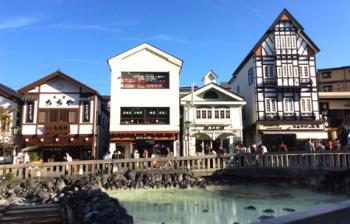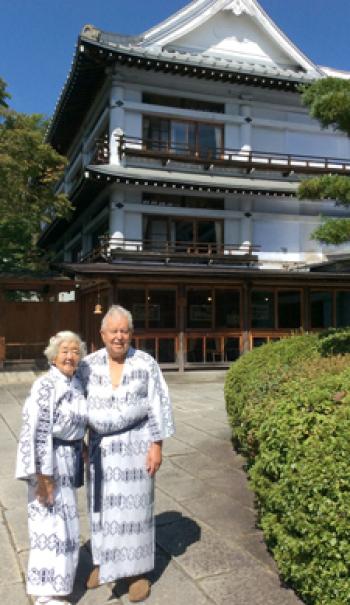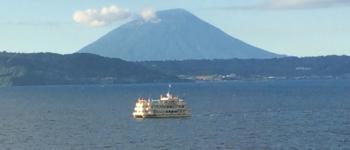Seeking onsens in Japan
This item appears on page 10 of the May 2020 issue.
In earlier days, many rice growers in Japan worked hard from March/April until late October/early November to tend to their fields, and after the harvest was over, they treated themselves to R&R by soaking in onsens (hot springs). Luckily, Japan is part of a volcanic chain, and there are thousands of hot springs.
Hot water and good food were the themes of the trip to Japan that my husband, Bernie, and I took, Sept. 16-Oct. 8, 2019.
Before leaving home, we ordered vouchers for 3-week Japan Rail Green Passes (for Green Car access) for ¥81,870 (near $754) per person. In Japan, when you exchange your voucher for the JR Pass, you have to show that your passport has a tourist visa in it.
During our 3-week trip, we stayed at a favorite hotel, the Lake View Toya Nonokaze Resort (29-1, Toyako-cho, Abuta-Gun-gun, Hokkaido; phone +81 0142-75-2600), at Lake Toya. It cost us ¥108,600 for two nights, with two meals each. There are restaurants in the hotel with Japanese, Chinese or Western chefs.
With floor-to-ceiling windows, guest rooms have views of the lake and a forested island. Across the lake, the view of Mount Yōtei (aka Ezo-Fuji, or the Mt. Fuji of Hokkaido) was fascinating.
From mid-April to mid-October, guests of lakeside hotels can see a spectacular fireworks show every night, as fireworks are set off from a boat. There is also a 700-passenger cruise ship that provides close-up views of the fireworks. Most hotels offer guests discount coupons for this cruise upon checking in. We took the boat ride, which cost about ¥700 ($6.50) per person and lasted 45 minutes.
• Hopping on a shinkansen (high-speed train), we made a couple of switches and arrived in Kusatsu, near the Japanese Alps. This place is well known for its natural hot springs with medicinal mineral water.
In the middle of town is a place called Yubatake where the water flows continuously from a spring. You can smell the sulfur a mile away. There are a few footbaths where anyone can remove their shoes and socks and soak their travel-worn feet in healing hot water. We could see a thick layer of sulfur sediment at the bottom.
We stayed at the Kusatsu Hotel (479 Kusatsu, Kusatsu-Machi, Agatsuma-Gun, Gunma, 377 1711, Japan; www.kusatsuhotel.com/english). Remodeled a few years ago, it is over 100 years old and has the charm of a bygone era.
For two nights, no meals included, it cost us ¥48,120. Our room was Japanese/Western in style and had a thick mattress on a raised platform — very comfortable!
• Next we headed to the hot-spring town of Togura Kamiyamada Onsen, where we had arranged for a hotel.
Except for our stay in Tokyo, where my nephew made arrangements for us, all of our hotel bookings on this trip were made through View Plazas (Japan Rail’s travel service centers), found only in major rail stations.
Upon arrival, we would tell the View Plaza staff what type of accommodations we wanted, and they would find the hotel for us. They would even arrange for the hotel to pick us up. Sometimes we would be given a hotel voucher and charged a nominal fee of ¥540.
We had never heard of Togura Kamiyamada Onsen, located near Nagano in the Japanese Alps, so we weren’t sure if we had done the right thing in going there, but we were pleasantly surprised, as it was a large, beautiful, well-maintained place.
We checked in at Seifuen (2-2-2 Kamiyamada, Onsen, Chikuma-shi, Nagano Pref.; phone 026 275 1016), paying ¥14,000 per person, which included breakfast and dinner.
There, we had a 14-course Japanese kaiseki (traditional multicourse meal) in a dining room, but there was a screen, so it was semiprivate. The food was delectable and beautifully presented.
Togura Kamiyamada is a quaint little town. The onsen experience was so memorable, we decided to return there the next time we visit Japan. I particularly want to go back to the Seifuen hotel. It was so peaceful and nature oriented, it really fit the idea of relaxing and enjoying your time.
The next morning, after a delicious breakfast with a view of a green mountain and the Chikuma River, we were shuttled to the rail station.
• From Nagano, we wanted to take a shinkansen to Kagoshima at the south end of Kyushu, but we were delayed, so we had to crash in Shin Yamaguchi Station. We just slept there, and the next morning at 10:45 a.m. we headed for Kagoshima, arriving around 3 p.m.
We had wanted to stay near the city center, but because the hotel we wanted was full, the View Plaza staff recommended the Shiroyama Hotel Kagoshima (41-1 Shinshoin-cho, Kagoshima shi; phone 099 224 2211). We weren’t sure we’d like being so far away from the city center, so we said we’d take a taxi there before reserving a room. Upon seeing the hotel, we liked it and decided to stay two nights.
The first night we paid ¥37,340 for two, including breakfast. The second night cost us only ¥21,600 because it was a Monday.
The hotel is over 3,000 feet above sea level, on top of Mt. Shiroyama, where we had a sweeping view of the city, Kagoshima Bay and Mount Sakurajima, one of the most violent, active volcanoes in Japan. Sure enough, the mountain was gracious enough to show us a glimpse of its mighty power on the first night.
The next day was beautiful and calm, so we bought the city’s public transport Cute Pass and rode the sightseeing bus. The pass allowed us to see the main sites and also covered a round-trip ferry ride to Mt. Sakurajima and a sightseeing bus there.
It was a nice, peaceful and enjoyable day, after which we continued our travels. If anyone wants to know more details, I can be reached at miyako.42@live.com.
MIYAKO STORCH
Santa Barbara, CA



